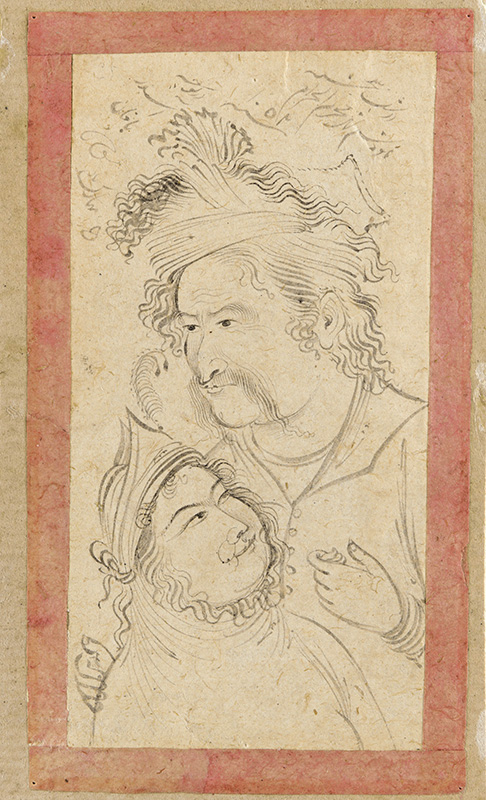Moʿin Moṣavver | Individual Drawings and Paintings
Drawing 1642.2
Two Lovers
Location: Smithsonian Institution, Freer Gallery of Art, no. F1953.41; formerly in the Sarre Collection, Berlin.
Drawing; (H x W) 13.2 x 6.8 cm.
Signature: Unsigned but dated 1052/1642.
Inscription
Written on a diagonal across the top: dar shab-e panj šanba yāzdahom-e šahr-e moḥarram al-ḥarām sana 1052 dar kucha āsdar bāgān mašqa. mobārak bād. Translation: “Drawn on Āsdar bāgān street on the evening preceding Thursday the eleventh of the sacred month of Moḥarram in the year 1052 / 11 April 1642. May he be blessed.” 11 April 1642 was a Friday, not a Thursday. The inscription is not signed.
Description:
The two lovers are portrayed in bust only. The young woman, whose face and shoulders appear on the left; her outer garment is pulled up tight under her neck and over her head, leaving only the face visible. Wisps of curly hair protrude from under and ring her face; a pointed tiara-shaped headband rests on her forehead. She admiringly looks up at her lover, a distinguished looking man of rough features, with a wrinkled brow, hooked nose, and handlebar mustache, who stares off to the left. With one hand he gently touches the young lady’s shoulder, while clutching her fingers in his other hand. The drawing is executed in a rapid brush technique with a special interest in the patterns formed by the repeating wavy lines used to render the hair, which protrudes in all directions from under a cloth band that encircles the man’s head.
Bibliography:
Sarre-mittwoch, ZRA_1914, p.36 and pl.30.
Sakisian, PM_1929, p.142 (not ill.).
Kühnel, Survey_1939 p.1894 (not ill.).
Stchoukine, SA_1964, p.64 (not ill.).
Commentary:
Although unsigned, the inscription is in the handwriting of Moʿin (cf. inscription no.1672.1). The young lady depicted is comparable with no.1642.1, and with other females in Moʿin’s manuscript paintings cited there. There is no exact comparison for the male, but miniature no.1670.1 has many characteristics in common - the wrinkled brow, the piercing eyes, the form of the ear and nose, the handlebar mustache - all of which leaves little doubt that both drawings are by the same hand. The Lovers appears to be a sketch drawn from life, for rarely does one encounter such temporal quality and tender expression of affection in Persian painting. The date of 1051/1642 recorded on the drawing seems quite plausible
Photo courtesy of The Freer Gallery of Art, Smithsonian Institution, © The Freer Gallery of Art
Robert Eng
Last Updated: October 28, 2018 | Originally published: October 28, 2018
Drawing 1642.2
Two Lovers
Location: Smithsonian Institution, Freer Gallery of Art, no. F1953.41; formerly in the Sarre Collection, Berlin.
Drawing; (H x W) 13.2 x 6.8 cm.
Signature: Unsigned but dated 1052/1642.
Inscription
Written on a diagonal across the top: dar shab-e panj šanba yāzdahom-e šahr-e moḥarram al-ḥarām sana 1052 dar kucha āsdar bāgān mašqa. mobārak bād. Translation: “Drawn on Āsdar bāgān street on the evening preceding Thursday the eleventh of the sacred month of Moḥarram in the year 1052 / 11 April 1642. May he be blessed.” 11 April 1642 was a Friday, not a Thursday. The inscription is not signed.
Description:
The two lovers are portrayed in bust only. The young woman, whose face and shoulders appear on the left; her outer garment is pulled up tight under her neck and over her head, leaving only the face visible. Wisps of curly hair protrude from under and ring her face; a pointed tiara-shaped headband rests on her forehead. She admiringly looks up at her lover, a distinguished looking man of rough features, with a wrinkled brow, hooked nose, and handlebar mustache, who stares off to the left. With one hand he gently touches the young lady’s shoulder, while clutching her fingers in his other hand. The drawing is executed in a rapid brush technique with a special interest in the patterns formed by the repeating wavy lines used to render the hair, which protrudes in all directions from under a cloth band that encircles the man’s head.
Bibliography:
Sarre-mittwoch, ZRA_1914, p.36 and pl.30.
Sakisian, PM_1929, p.142 (not ill.).
Kühnel, Survey_1939 p.1894 (not ill.).
Stchoukine, SA_1964, p.64 (not ill.).
Commentary:
Although unsigned, the inscription is in the handwriting of Moʿin (cf. inscription no.1672.1). The young lady depicted is comparable with no.1642.1, and with other females in Moʿin’s manuscript paintings cited there. There is no exact comparison for the male, but miniature no.1670.1 has many characteristics in common - the wrinkled brow, the piercing eyes, the form of the ear and nose, the handlebar mustache - all of which leaves little doubt that both drawings are by the same hand. The Lovers appears to be a sketch drawn from life, for rarely does one encounter such temporal quality and tender expression of affection in Persian painting. The date of 1051/1642 recorded on the drawing seems quite plausible
Photo courtesy of The Freer Gallery of Art, Smithsonian Institution, © The Freer Gallery of Art
Robert Eng
Last Updated: October 28, 2018 | Originally published: October 28, 2018
